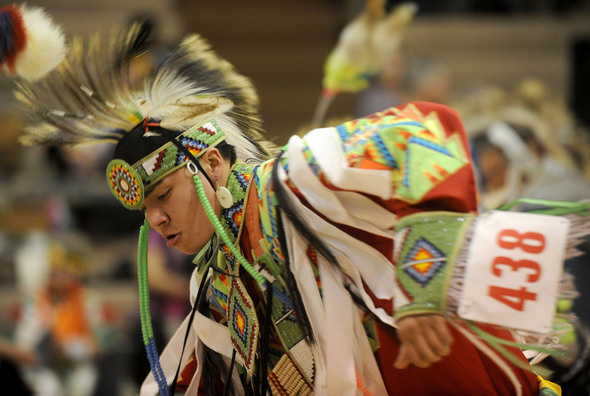Annual Dance for Mother Earth Powwow is a cornucopia of color and sound

19-year-old Madison Heights resident DJ Whitehouse of the Shoshone Paiute tribe participates in a grass dance during the Dance for Mother Earth Powwow at Saline Middle School in Saline, Mich. on March 19th, 2011.
Angela Cesare | AnnArbor.com
"I've been involved with this powwow since I was a freshman," said Alley, a co-chair of NASA and a member of the Pokagon Band of the Potawatomi. "I've been going to powwows since I was young, and have always found it to be an exciting time to see community members and family."
This year's powwow goes on through Sunday at 6 p.m. at Saline Middle School on Maple Road. It's a student-led event in its 39th year, and preparation began the day after last year's powwow ended.
"The student aspect is challenging because we are all trying to do so much," said Veronica Pasfield, a graduate student at U of M in the American Culture program, and a member of the Ojibwe. "I've been going to powwows since I was a kid, and it was always the highlight of the year. This one is known as one of the best powwows in the Midwest, and people come from all around Michigan as well as drawing people in nationally."
The U of M powwow started in the early 1970s when the native student community began to grow. Thanks to the dedication of the students and the support of the native community in the greater Detroit area, which Pasfield says is close to 68,000 and is the largest in the state, this powwow has remained a popular event.
"The reason native communities love to put on powwows is that it's one of the few public spaces where we can control how our culture is presented," said Pasfield. "There is tremendous diversity but also common threads."
The powwow includes singers, dancers, artists and craftspeople from around the state and representing a diverse group of nations and tribes.
It is set up in circles, and in the tradition of native cultures, one enters the circles from the east. Following a drum roll in which circles of drummers play and chant in harmony, the grand entry officially begins the powwow, and dancers and flag carriers from different communities line up behind the head veteran.
During the day there are Intertribals, when people from different nations share the dance floor. Many come dressed in regalia handmade and unique in their colors, yarn, cloth and other materials. From feathers to jingles to intricate bead work, the regalia is striking.
The event has strong support from U of M faculty members such as Phil Deloria, a professor of History, American Studies and Native American Studies and Associate Dean for Undergraduate Education at the college of Literature, Science and the Arts.
"The University of Michigan has a robust program for Native American studies including literary courses, anthropology, and religious studies," said Deloria, who himself comes from a family with a long native history that goes back to the Sioux in South Dakota. "Students take the lead in orchestrating this powwow, and we support them with financial resources."
Deloria says that Michigan's tribes are "amazing and a real presence in the state."
For more information on the 2011 39th Annual Dance for Mother Earth Powwow, go to www.umich.edu/~powwow/. Admission is $10 for adults, with special rates for students, seniors and children. A shuttle bus is available from the Michigan Union on the hour. The powwow is open until 8 p.m. Saturday, and from 10 a.m. to 6 p.m. Sunday.
Lisa Carolin is a freelance writer for AnnArbor.com. Contact the news desk at news@annarbor.com.


Comments
HADES
Sun, Mar 20, 2011 : 9:17 p.m.
Dr. I. Emsayin, "Schools drive their students to the African American Museum, to the Arab American Museum, to the Holocaust Museum, but at the pow wow there is an opportunity to engage with a living culture to which most local students are not exposed. " I agree with you. I was at the pow wow and it didn't seem like there were a lot of people there. Which is weird since they are holding it at a local school. You would think that the teachers would have had their students attend the event.
Dr. I. Emsayin
Sun, Mar 20, 2011 : 12:08 p.m.
I would think that local teachers would want their students to have an opportunity to see Native Americans in regalia dancing and drumming at this event. Saline, Dexter, Ann Arbor and Chelsea teachers as well as homeschool teachers should put attendance at the pow wow on the top of their agenda. Schools drive their students to the African American Museum, to the Arab American Museum, to the Holocaust Museum, but at the pow wow there is an opportunity to engage with a living culture to which most local students are not exposed. Next year the curriculum of local districts should stress this wonderful opportunity that so many local residents miss.
local
Sun, Mar 20, 2011 : 12:54 p.m.
my kids teacher offered it as a little "extra credit" if they went yesterday. They are doing a Native American unit right now and really pushed to have the kids go check it out. Was very cool!!
meechigan
Sat, Mar 19, 2011 : 8:58 p.m.
The link above doesn't forward correctly and results in a page not found error. The new site is smaller and with the economy there are less vendors but you should go if you have a chance.
Jen Eyer
Sat, Mar 19, 2011 : 9:07 p.m.
Thank you. The link has been fixed.